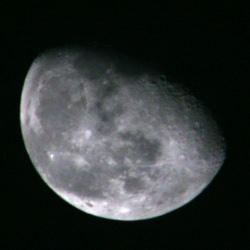
Image credit: Jamie Johnstone. Click to enlarge

Space and astronomy news

Image credit: Jamie Johnstone. Click to enlarge
Forget about nuclear weapons, if you need to move a dangerous asteroid, you should use a tractor beam. Think that’s just Star Trek science? Think again. A team of NASA astronauts have recently published a paper in the Journal Nature. They’re proposing an interesting strategy that would use the gravity of an ion-powered spacecraft parked beside an asteroid to slowly shift it out of a hazardous orbit. Dr. Stanley G. Love is member of the team and speaks to me from his office in Houston.
Continue reading “Podcast: Gravity Tractor Beam for Asteroids”
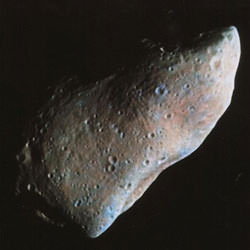
Asteroid 951 Gaspra taken by the Galileo spacecraft. Image credit: NASA/JPL. Click to enlarge.
Listen to the interview: Gravity Tractor Beam (4.8 MB)
Or subscribe to the Podcast: universetoday.com/audio.xml
Fraser Cain: Dealing with asteroids that are going to hit the Earth, now as I understand it, you need to find a crew of top quality oil miners. And you need to put them on the Space Shuttle and send them with a bunch of nuclear bombs to the asteroid to blow it up. Now you’re telling me that maybe this isn’t the best way?
Dr. Stanley G. Love: Well, it depends on what your goal is. If your goal is to make a movie that’s going to make a ton of money, then go wild; that’s exactly the right way to do it. If your goal is to actually prevent an impact with the Earth, though, we’re hoping there might be a simpler method of dealing with this.
Fraser: All right, so what’s the simpler method that you’re suggesting?
Love: Well, the method that we’re suggesting is to send a relatively large and heavy spacecraft – not so large and heavy that we can’t imagine it – to the asteroid, and instead of trying to blow up the asteroid, or land on it and push the thing aside (both of those ideas have been suggested, but they have some difficulties), we’re suggesting you just park the spacecraft next to it and let it hover there. And if you let it hover there for something like a year, very very gradually, the tiny gravitational pull between the asteroid and the spacecraft is going to pull the asteroid over in the direction of the spacecraft. The spacecraft is hovering in a constant distance from the asteroid, and what this means is that it’s very gradually pulling the asteroid off course using gravity as sort of a tow line. And if you can get enough warning on your asteroid – if you know it’s coming 20 years or so before it’s going to hit – then you can get the spacecraft out there and have it pull for about a year, you can pull it enough so that instead of hitting the Earth, it will miss the Earth.
Fraser: Now all the media, and all of those disaster movies revolve around some astronomer spotting a dangerous asteroid three months before it’s going to hit. It sounds like your solution is more in the 20 year range. Do you think that’s the more realistic scenario now these days?
Love: It’s hard to know. We haven’t really discovered all of the asteroids that could potentially hit the Earth yet. We’ve got a lot of people very busily working on that problem; there are searches going on every night. I think a lot of them are automated, and not some lonely guy on a mountaintop with his eye to the lens of a telescope there. And it is possible that tomorrow we could realize that there’s something coming that could hit us that we didn’t know about and it could be three months away from impacting the Earth. That would be certainly unfortunate. But in the future we are likely to know all these things; know all their orbits, and we can predict a hit long before it’s going to hit us. And that’s the sort of scenario that our solution will be able to deal with.
Fraser: And so what size of asteroids would you be able to deal with?
Love: A couple hundred metres in size. So the size of a football stadium or convention center.
Fraser: And what would the spacecraft itself look like? What kind of components would it have on it?
Love: When we came up with the idea for our little paper, we pulled a spacecraft design essentially off the shelf. It’s NASA’s Prometheus project, where they were going to send a large nuclear powered spacecraft to orbit Jupiter’s moon Europa, and do a lot of interesting science there. It’s a 20-ton spacecraft with electric thrusters, that is it uses electric power to heat a gas to extremely high temperatures and squirt it out the back. You get marvelous fuel economy; a lot of ability to move a spacecraft with a small amount of fuel, but the thrust is really low. You can only get a newton, or so (a fifth of a pound) of force. So you have a large electric propulsion, nuclear powered spacecraft – this is probably going to be a long skinny thing, because you’ll need a lot of radiators to reject the waste heat from the nuclear reactor. It’s going to have a set of thrusters, a fuel tank, and some guidance and navigation components. Depending on how you set this spacecraft up, we decided that if you put the reactor, which is heavy, and the fuel tank, which is heavy, down close to the asteroid – hanging from the thrusters – then you get more mass close to the asteroid, and that increases your gravitational pull as gravitational pull decreases rapidly as you increase the distance between the two masses. And it also helps stabilize your spacecraft and just helps you all around if you put your heavy components hanging down by the asteroid with the thrusters up at the top.
Fraser: Oh, I see, it would almost be if you had a ball at the end of a rope, hanging down with the heavy part – the reactor and all the fuel – hanging as close to the asteroid as you can, while all the thrusters are further up the rope pulling it away.
Love: That’s exactly right. Of course you need to tip your thrusters out away so the plume of hot gas coming out of them doesn’t hit the asteroid. It does no good trying to pull an asteroid closer to you with gravity and at the same time that you are pushing at it with your thruster plumes. So you need those outward so the plumes miss the asteroid and that will help improve your towing force.
Fraser: Now do you have any targets that you think might be a good victim of this kind of movement strategy?
Love: We were sort of developing the idea as a generic idea, and fly to anything. However, there’s Asteroid 99942 Apophis which is supposed to make a close pass of the Earth I think in 2029. And if that asteroid happens to pass through exactly the right point in space as it goes past the Earth, it has a chance to come back in 7-8 years and hit us, which would be bad. And that asteroid is an excellent target for this kind of a mission. If we can get to it before that first Earth flyby, that would line it up for impact the second time around. And the reason for that is that these flybys warp the path of the asteroid so that a tiny tiny change in the flight direction before the flyby gives a huge change in the flight direction after the flyby. So it’s like a bank shot in pool. A little tiny mistake on the first part, after the bounce, the mistake gets multiplied. So you could use a gravitational tractor that wasn’t nuclear powered and didn’t weight 20 tons. You could use a 1-ton, chemical-propelled gravity tractor to pull this asteroid just slightly off course before that Earth flyby so the asteroid is going no where near us.
Fraser: I see, if you have an asteroid that coming towards us 20 years out, you could move your big ion engine-powered tractor. How long would you need to have it spend next to the asteroid?
Love: About a year.
Fraser: But if it’s just about to do the flyby, you could give it a very small change and it would still kick it out of the bad orbit and into a good orbit.
Love: Right, you’re going to use that flyby of the Earth to multiply the tiny effect you put on the asteroid with your spacecraft before the flyby. And then after the flyby, the effect is much greater.
Fraser: So what’s the stage of your proposal now? What’s the future for it right now?
Love: Well it hard to know. Right now we’ve made a proposal, we’ve gotten the idea out there, and people are talking about it. My co-author, Ed Lu and I have written many scientific papers for publication, and none of them have received even a tenth as much attention as this one. So the idea’s out there, and we’ll see what happens. I think the debate will become much more pointed if we actually do discover an asteroid that’s on a collision path with the Earth. Then we’ll really need to get together and decide what we’re going to do about it.
Fraser: Well that’s my concern with the whole process of protecting the Earth from asteroids. There’s a lot of uncertainty in predicting when and where an asteroid is going to hit. The better you can mark the orbit, the better you can know if it’s going to be a risk. In many cases, if you’ve got these ones that are 30 years out, decision makers and lawmakers might say: well, let’s wait until we know better. And yet, the more you know better, the less chance you have of changing its orbit.
Love: Yes, that’s always true, and human nature plays into this a lot. Nobody’s every suffered an asteroid strike, so it’s hard to compare it to things that we have suffered, like tsunamis and hurricanes to take a couple of recent examples. The things that we know about and experience in a person’s lifetime are always easier to visualize and understand. And to get people to pay attention to something that seems kind of esoteric and science fictiony; is this real, or are people just making it up? I don’t know a good solution to that, but the fact that people are talking about the idea and thinking about it – and not just in the elevated circles of academia – all over the world, I think is a good sign. At least we’re thinking about the problem and how to solve it.
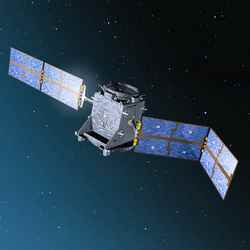
GIOVE-A deploys its solar arrays. Image credit: ESA . Click to enlarge
The first Galileo demonstrator is in orbit, marking the very first step to full operability of Europe’s new global navigation satellite system, under a partnership between ESA and the European Commission (EC).
Giove A, the first Galileo in-orbit validation element, was launched today from Baikonur, Kazakhstan, atop a Soyuz-Fregat vehicle operated by Starsem. Following a textbook lift-off at 05:19 UTC (06:19 CET), the Fregat upper stage performed a series of manoeuvres to reach a circular orbit at an altitude of 23 258 km, inclined at 56 degrees to the Equator, before safely deploying the satellite at 09:01:39 UTC (10:01:39 CET).
“Years of fruitful cooperation between ESA and the EC have now provided a new facility in space for improving the life of European citizens on Earth” said ESA Director General Jean Jacques Dordain congratulating ESA and industrial teams on the successful launch.
This 600 kg satellite, built by Surrey Satellite Technology Ltd (SSTL) of Guildford, in the UK, has a threefold mission. First, it will secure use of the frequencies allocated by the International Telecommunications Union (ITU) for the Galileo system. Second, it will demonstrate critical technologies for the navigation payload of future operational Galileo satellites. Third, it will characterise the radiation environment of the orbits planned for the Galileo constellation.
Formerly known as GSTB-V2/A (Galileo System Test Bed Version 2), Giove A carries two redundant, small-size rubidium atomic clocks, each with a stability of 10 nanoseconds per day, and two signal generation units, one able to generate a simple Galileo signal and the other, more representative Galileo signals. These two signals will be broadcast through an L-band phased-array antenna designed to cover all of the visible Earth under the satellite. Two instruments will monitor the types of radiation to which the satellite is exposed during its two year mission.
The satellite is under the control of SSTL’s own ground station. All systems are performing well, the solar arrays are deployed and in-orbit checkout of the satellite has begun. Once the payload is activated, the Galileo signals broadcast by Giove A will be carefully analysed by ground stations to make sure they satisfy the criteria of the ITU filings.
First step for Galileo
A second demonstrator satellite, Giove B, built by the European consortium Galileo Industries, is currently being tested and will be launched later. It is due to demonstrate the Passive Hydrogen Maser (PHM), which, with a stability better than 1 nanosecond per day, will be the most accurate atomic clock ever launched into orbit. Two PHMs will be used as primary clocks onboard the operational Galileo satellites, with two rubidium clocks serving as backups.
Subsequently, four operational satellites will be launched to validate the basic Galileo space and related ground segments. Once this In-Orbit Validation (IOV) phase is completed, the remaining satellites will be launched to achieve Full Operational Capability (FOC).
Galileo will be Europe’s own global navigation satellite system, providing a highly accurate, guaranteed global positioning service under civilian control. It will be inter-operable with the US Global Positioning System (GPS) and Russia’s Global Navigation Satellite System (Glonass), the two other global satellite navigation systems. Galileo will deliver real-time positioning accuracy down to the metric range with unrivaled integrity.
Numerous applications are planned for Galileo, including positioning and derived value-added services for transport by road, rail, air and sea, fisheries and agriculture, oil prospecting, civil protection activities, building, public works and telecommunications.
Original Source: ESA Portal
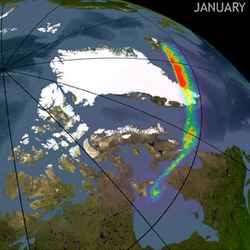
Low-energy X-rays are generated during auroral activity. Image credit: NASA. Click to enlarge
A team of scientists observed Earth’s north polar region ten times during a four-month period in 2004. As the bright arcs in this sample of images show, they discovered low-energy (0.1 – 10 kilo electron volts) X-rays generated during auroral activity. Other satellite observatories had previously detected high-energy X-rays from Earth’s auroras.
The images – seen here superimposed on a simulated image of the Earth – are from approximately 20-minute scans during which Chandra was pointed at a fixed point in the sky while the Earth’s motion carried the auroral region through the field of view. The color code of the X-ray arcs represents the brightness of the X-rays, with maximum brightness shown in red.
Auroras are produced by solar storms that eject clouds of energetic charged particles. These particles are deflected when they encounter the Earth’s magnetic field, but in the process large electric voltages are created. Electrons trapped in the Earth’s magnetic field are accelerated by these voltages and spiral along the magnetic field into the polar regions. There they collide with atoms high in the atmosphere and emit X-rays.
Original Source: Chandra X-ray Observatory

The Apollo 11 flight put the first humans onto the Moon’s surface. This culmination of the space race between the USA and the USSR is the watershed in human space travel. Though a singularly exciting event in its own right, this mission was many years in the making and needed the contribution of tens of thousands across the country. As such, there was a deserved celebration when the Command Module slowly descended into the Pacific Ocean 8 days after launch.
Godwin’s space guide for this event is necessarily abbreviated and succinct, as it is just a guide. An historical overview begins with Miletus predicting a solar eclipse in 585 BCE, speeds past the Montgolfiers and their balloons, then plants the reader at the beginning of the space race. This was when both the US and USSR planned to launch a satellite during the International Geophysical Year of 1957. The guide continues with the Apollo program’s immediate predecessors, the Redstone program, the Gemini program and touches on the big decisions for Apollo itself, such as the rendezvous method. Brief backgrounds of the astronauts follow and then a step by step listing of major flight events, each aligned with a corroborating time line. The written section of the guide concludes with a description of the experimental equipment and other ancillary gear. Much is omitted but, for a guide, Godwin picks just the right amount of just the right facts to make it interesting and pertinent.
The remainder of the guide, nearly half, is filled with coloured drawings and photographs. There’s the rocket and the Command/Service Module in graphic detail. Artist’s imagery help visualize important points in Apollo 11’s flight, such as docking, separation and descent. Last, many wonderful photographs and video cuts position the reader back to this inspiring time as men first walked the lunar surface.
By being precise, Godwin has ably written a guide for space enthusiasts. Sufficient details allow the reader to grasp the immensity of the endeavour without being overpowered by minutiae. The historical lead-in smoothly sets the scene of the Apollo era. Facts and data corroborate the magnitude. And, the photographs leave no doubt that the program did have men successfully go to the Moon and return. Some shortcuts are evident; there’s no table of contents nor index. Also, many of the images don’t have credits, though we can safely guess that most if not all are direct from NASA. Nevertheless, given the hour or so to read, this guide will sit comfortably with many young space dreamers.
Also, as found on the review copy, there’s a slip cover advertising the IMAX film ‘Magnificent Desolation’. The film relives many of the moments from all the Apollo missions and is thus a great companion to the guide (or vice versa).
For many, short newsclips are the sole window to the ever changing world about them. Equally brief guides might be all that some can or want to invest into history, no matter how recent. Robert Godwin in his pocket space guide Apollo 11 satisfies this need in his clear and colourful review of the Apollo program’s first successful lunar lander.
Review by Mark Mortimer
Read more reviews online, or purchase a copy from Amazon.com.
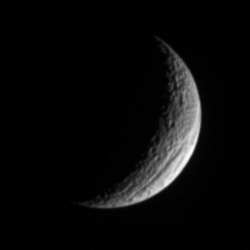
Tethys shows off its great scar. Image credit: NASA/JPL/SSI Click to enlarge
A crescent Tethys shows off its great scar, Ithaca Chasma, for which the moon is renowned. The chasm is 100 kilometers (60 miles) across on average, and is 4 kilometers (2 miles) deep in places.
See Steep Scarps for a much closer view of the chasm taken during a Cassini flyby.
Ithaca Chasma is the most prominent sign of ancient geologic activity on Tethys (1,071 kilometers, or 665 miles across), whose surface is characterized principally by heavy cratering.
The lit surface visible here is on the moon’s Saturn-facing hemisphere. North on Tethys is straight up.
The image was taken with the Cassini spacecraft narrow-angle camera on Nov. 28, 2005 using a filter sensitive to wavelengths of infrared light centered at 930 nanometers. The view was acquired at a distance of approximately 1.1 million kilometers (700,000 miles) from Tethys and at a Sun-Tethys-spacecraft, or phase, angle of 123 degrees. Resolution in the original image was 6 kilometers (4 miles) per pixel. The image has been magnified by a factor of two and contrast-enhanced to aid visibility.
The Cassini-Huygens mission is a cooperative project of NASA, the European Space Agency and the Italian Space Agency. The Jet Propulsion Laboratory, a division of the California Institute of Technology in Pasadena, manages the mission for NASA’s Science Mission Directorate, Washington, D.C. The Cassini orbiter and its two onboard cameras were designed, developed and assembled at JPL. The imaging operations center is based at the Space Science Institute in Boulder, Colo.
For more information about the Cassini-Huygens mission visit http://saturn.jpl.nasa.gov . The Cassini imaging team homepage is at http://ciclops.org .
Original Source: NASA/JPL/SSI News Release
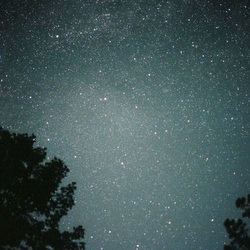
Image credit: Hulett Keaton. Click to enlarge

Image credit: Hulett Keaton. Click to enlarge
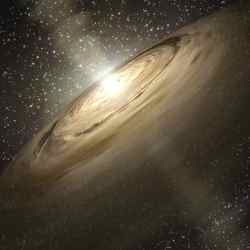
An artist’s impression of the dusty disk orbiting IRS 46. Image credit: NASA/JPL-Caltech Click to enlarge
Astronomers at W. M. Keck Observatory have found ??bf? for the first time ??bf? some of the basic compounds necessary to build organic molecules and one of the bases found in DNA within the inner regions of a planet-forming disk. The object, known as “IRS 46,” is located in the Milky Way galaxy, about 375 light years from Earth, in the constellation Ophiuchus. The results will be published in an upcoming issue of the Astrophysical Journal Letters.
“We see prebiotic organic molecules in comets and the gas giant planets in our own solar system and wonder, where did these chemicals come from?” said Dr. Marc Kassis, support astronomer at the W. M. Keck Observatory. “The Spitzer Space Telescope is letting us study these young stellar objects in new and revealing ways, giving us exciting clues about where life may form in the universe.”
The two organic compounds found — acetylene and hydrogen cyanide — are commonly found in our own solar system, such as the atmospheres of the giant gas planets, the icy surfaces of comets, and the atmosphere of Saturn??bf?s largest moon, Titan. Another carbon-containing species detected, carbon dioxide, is widespread in the atmospheres of Venus, the Earth, and Mars.
“If you add hydrogen cyanide, acetylene and water together in a test tube, and give them an appropriate surface on which to be concentrated and react, you’ll get a slew of organic compounds including amino acids and a DNA purine base called adenine,” said Keck Astronomer Dr. Geoffrey Blake, of the California Institute of Technology in Pasadena and co-author of the paper. “Now, we can detect these same molecules in the planet zone of a star hundreds of light-years away.”
The presence of gas-rich disks around young stars is well known, but little is understood about the chemical structure inside. The discovery of acetylene and hydrogen cyanide in one of these disks will help astronomers better understand these disks, where future solar systems may someday form and possibly result in life.
“Spitzer found something very unique — a young protostar with a dusty disk that, when viewed from Earth, appears tilted on the sky, similar to how some galaxies appear,” Kassis explained. “This viewing angle let the team use Keck-NIRSPEC data to study the inner regions of the disk. The results told the team exactly how the disk was moving and suggest there may be a stellar wind coming from the inner region. Keck also helped measure the high temperatures and the particle concentration in the disk.”
The dust and gas surrounding a young star blocks visible light, but lets longer wavelengths, such as infrared light, pass through. Astronomers can find out what this gas and dust is made of by separating the light into its component wavelengths, or colors.
Since 2003, the NASA Spitzer Space Telescope has allowed astronomers to use this technique to study molecular compounds in protoplanetary disks of young stellar objects. The Spitzer “c2d legacy program” has looked at more than 100 sources in five nearby star-forming regions and only one ??bf? IRS 46 ??bf? showed clear evidence of containing the organic compounds in the warm regions close to the star where terrestrial planets are most likely to form.
“This infant system might look a lot like ours did billions of years ago, before life arose on Earth,” said Fred Lahuis of Leiden Observatory in the Netherlands and the SRON Netherlands Institute for Space Research. Lahuis is the lead author of the paper describing the results.
While the precise events leading up to self-replicating nucleic acids remains unclear, the molecules of acetylene (C2H2) and hydrogen cyanide (HCN) have been shown to produce the base compounds necessary to build RNA and DNA. The team found that the abundance of hydrogen cyanide (HCN) was nearly 10,000 times higher than that found in cold interstellar gas from which stars and planets are born.
Models of early solar-system chemistry have historically centered on data from our own primitive solar system, but now discoveries of protoplanetary disks have opened the field to solar systems other than our own. Theoretical models have suggested that large quantities of complex organic molecules would be present in the inner-most regions of these disks, but until now, no observational tests have been possible.
To help determine where, exactly, the organic-rich gas resides in IRS 46, the team also used submillimeter data from the James Clerk Maxwell Telescope on Mauna Kea. The faint signals observed again suggest that the material originates from the inner disk, perhaps no more 10 astronomical units from the parent star, similar in distance to where Saturn orbits the Sun in our own solar system. However, much additional work remains to be done to know this for certain.
“The gases are very warm, close to or somewhat above the boiling point of water on Earth,” said Dr. Adwin Boogert, also of Caltech. “These high temperatures helped to pinpoint the location of the gases in the disk.”
The Keck-NIRSPEC results point to the presence of a stellar wind emerging from the inner region of the disk orbiting IRS 46. The wind may eventually blow away the dusty debris in the disk, perhaps revealing the presence of rocky, Earth-like planets in several million years.
The Jet Propulsion Laboratory manages the Spitzer Space Telescope mission for NASA’s Science Mission Directorate, Washington. Science operations are conducted at the Spitzer Science Center at Caltech. JPL is a division of Caltech.
The W. M. Keck Observatory is managed by the California Association for Research in Astronomy, a non-profit 501 (c) (3) corporation. The Keck I and Keck II 10-meter telescopes probe the faintest objects in the optical and infrared Universe.
Original Source: W. M. Keck Observatory